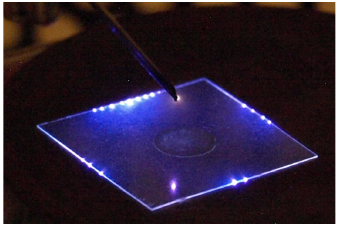
Recovery and resilience plan.


We investigate bio-decontamination of water on selected Gram-negative and Gram-positive bacteria (Escherichia coli, Salmonella typhimurium and Bacillus cereus), and yeasts (Saccharomyces cerevisiae) by several types of electrical discharges in atmospheric pressure air, some combined with water.
Our first bio-decontamination results were obtained in the static regime where a batch sample of contaminated water was treated for a certain time (15, 30, 60 s). By comparing the three discharges tested (streamer corona, transient spark and glow discharge) we found the highest biocidal efficiency in the transient spark, and the lowest in the streamer corona (Machala Z., et al., 2009).
The highest bactericidal efficiencies in water have been obtained in transient spark (TS) air discharge in two water flowing systems: water electrospray and circulating water electrode. The water electrode (WE) system, depicted in Fig. 1a, consisted of high voltage hollow needle electrode placed above the inclined grounded plane electrode in point-to-plane geometry. In this system, the water solution was supplied via a narrow channel in the plane electrode and circulated by a peristaltic pump with various flow rates (up to 30 mL/min). The water spray (WS) system, depicted in Fig. 1b and described in detail in (Pongrac et al., 2014 a, b) consisted of high voltage hollow needle electrode placed above the grounded mesh electrode, also in the point-to-plane geometry. The water solution was supplied via the needle with a constant flow rate (0.5 mL/min). Thanks to the applied high voltage the solution was electrosprayed through the active zone of the discharge and then collected under the metallic mesh. The chemical and biological effects of the direct discharge action on water solutions were investigated and compared to the indirect exposure to discharge activated gas flow using the setup depicted in Fig. 1c. The setup was similar to Fig.1b, but instead of supplying the solution via the discharge zone, the batch sample (water solution) was placed 1-2 mm under the grounded mesh electrode.
The bactericidal efficiency of TS in water expressed as a logarithmic reduction is depicted in Fig. 2. In both TS WE and WS systems, the stronger bactericidal effect was observed in deionized or normal (non-buffered) water (3-5 log) than in buffered (PB) solutions (1-2 log), which is linked with the different reactive oxygen/nitrogen species (RONS) chemistry associated with acidification (down to pH ~ 3). WS system was slightly more bactericidal probably due to the effect of the electrospray, where the treated water solution is sprayed to micrometric size droplets, which enhances the surface-to-volume ratio and thus the mass transfer of RONS formed in the gas phase into the solution.